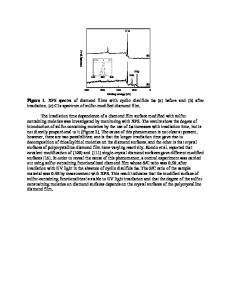Chemical Modification of Graphene
- PDF / 903,983 Bytes
- 23 Pages / 612 x 792 pts (letter) Page_size
- 83 Downloads / 352 Views
EW
Chemical Modification of Graphene I. I. Kulakovaa and G. V. Lisichkina,* a Lomonosov
Moscow State University, Moscow, 119991 Russia *e-mail: [email protected]
Received June 29, 2020; revised August 9, 2020; accepted August 11, 2020
Abstract—Methods of graphene preparation, its structure, physical and chemical properties are reviewed. Two stages of chemical modification of graphene are described—primary (functionalization) and secondary (covalent attachment of organic compounds). The main attention is paid to methods for the synthesis of graphene derivatives: oxide, graphane, halides, nitrogen-containing compounds, and conjugates of graphene and graphene oxide with organic and bioorganic molecules. The main areas of potential application of modified graphene materials are briefly considered. Biomedicine and medical diagnostics are the most promising areas of practical use of graphene conjugates and materials based on it. However, detailed studies of the toxicity of graphene and its derivatives should be carried out. Keywords: graphene, graphene oxide, carbon nanotubes, modification, graphene conjugates
DOI: 10.1134/S1070363220100151 1. Introduction 2. General information on graphene 3. Properties of graphene 4. Graphene and its conjugates with biologically active compounds and drugs 5. Conclusions
1. INTRODUCTION Graphene, two-dimensional allotrope of carbon formed by an atomic layer with thickness of one atom, is the youngest representative of the nanocarbons family [1]. Graphene was discovered in 2004, more than half a century after its prediction, and novel application areas of graphene have recently emerged. At some point, graphene studies were not considered, since that two-dimensional object was believed to be unstable. However, this has been disproved. Graphene and its derivatives as well as the materials based on it can be potentially applied in various areas including aerospace industry, motorcar industry, electronics, distributed energy, ecology, biomedicine, and health care. Transistors [2, 3], atomic force microscopy cantilevers [4], chemosensors [5], etc. have been developed basing on graphene. Industrial trials of elements of devices or small-batch production are in progress in certain industries, whereas clinical trials using graphene-containing projects are under way in biomedicine.
1601 1602 1606 1617 1620
The promises of graphene use in such biomedical applications as in vivo monitoring, targeted stimulation, and high-precision registration of brain neurons activity seem fantastic [6]. Such studies will lead to the creation of novel technologies of neuroprosthetics and neural interfaces which can directly transmit data between brain and computer. The application of relatively expensive graphene has been limited primarily to the industries dealing with extremely high-price products, the contribution of graphene into cost of which is reasonable as well as the miniature devices (presuming low graphene demand) such as environmental sensors, biosensors, etc. Fortunately, the graphene pr
Data Loading...










